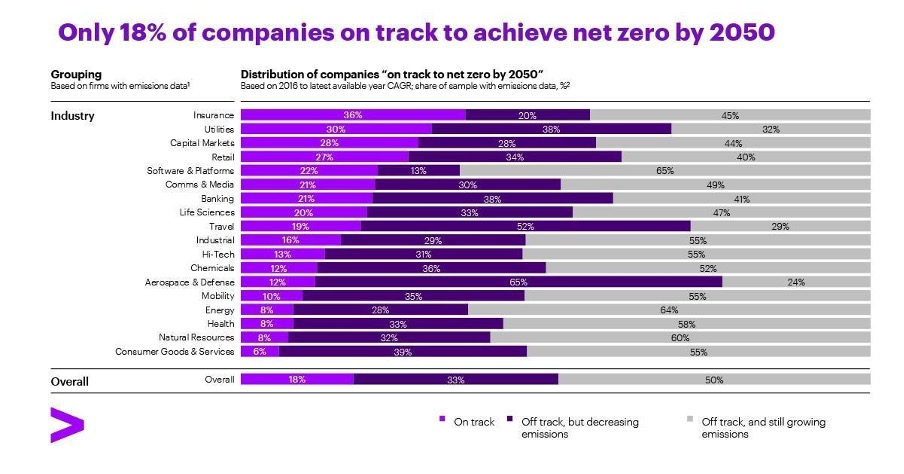To achieve our target of restricting global warming to 1.5C, global greenhouse gas (GHG) emissions must reach their highest point by 2025, drop by 43% by 2030, and ultimately hit net zero by 2050. However, despite advancements in decarbonisation efforts, our present plan indicates a shortfall in meeting these benchmarks. Restoring our trajectory has been the primary focus of discussions at COP28.
The fundamental role business has to play
Data from the latest Accenture report, Destination Net Zero, states that 37% of G2000 companies have made a commitment to achieve net zero, marking a 3-percentage-point increase since 2022. However, our findings indicate that only one-fifth (18%) of these companies are currently on track to cut their emissions to net zero by 2050, while over half have not yet begun any initiatives to reduce emissions.

The report also incorporated data from 28 of Australia’s top revenue-generating companies. Initial observations are promising: 96% of the Australian companies surveyed have established net zero objectives, contrasting with 55% of their counterparts in other regions. Moreover, 75% have disclosed net zero objectives in all areas, in contrast to 57% in the EU and 26% in the US. Despite the small sample size, the commitment is significant, given the understanding that companies setting targets tend to reduce emissions more rapidly than those that do not. However, substantial action is yet to follow suit.
The report also found that Australia faces significant challenges in achieving substantial decarbonisation as companies are over-reliant on carbon offsetting due to Australia’s heavy dependence on fossil fuels, which sees higher offsets to meet climate goals. The disparity is over double the global figure of 27%, with 64% of Australian businesses utilising carbon offsets to meet their emission targets. Yet only 11% were actively looking to adapt their business models to achieve lower carbon emissions. Given this, what is the next step for Australia? How do we speed up efforts for substantial results?
Expanding decarbonisation adoption
Boosting the use of decarbonisation methods in businesses is crucial for faster emission reduction. Our research indicates that adopting 10 or more methods leads to significant emission decreases, while using fewer may result in continued emission growth.
Businesses should combine multiple decarbonisation measures, a practice known as “stacking” levers. The levers include renewable energy adoption, process optimisation, sustainable sourcing as well as more complex actions such as upgrading to “green” technology and reinventing business models. When combined, each lever strengthen the impact of the others, establishing a more resilient and adaptable framework for sustainable business practices.
Out of the levers, G2000 companies are predominantly implementing energy efficiency (82%), reducing waste (80%), switching to renewables (79%), and adopting circular principles (68%); the commonality of these levers signifying a ‘starting point’ for companies on their decarbonisation journeys. While the relatively uncommon choices are concentrated in certain sectors, reflecting their specific needs and priorities. Greener IT infrastructure, for example, is being consolidated within companies likely to contribute to a greater share of these emissions.
Energy-intensive industry transitions
Industries like steel, metals, mining, cement, chemicals, freight and logistics jointly account for nearly half (40%) of worldwide CO2 emissions. The industry’s Scope 1 and 2 emissions also extend to become their customers’ Scope 3 emissions, making the sustainable transformation of these sectors pivotal for effective climate mitigation efforts.
Yet, expecting companies within this sector to bear the entire responsibility of the energy transition without assistance is counterproductive. Ultimately, decarbonisation hinges on cost factors as environmentally friendly alternatives to high-carbon products and services are more costly and less accessible. To achieve net zero emissions, there is a pressing need to increase the speed at which we reduce these costs.
Promoting investment in advanced technologies, such as green hydrogen production, renewable energy and AI-driven sustainable mining, has the potential to significantly decrease carbon footprints in these industries and lower emissions throughout the supply chain. Establishing new industrial clusters, comparable to the Kwinana cluster in Western Australia, holds potential for sustainable transformation of the secondary industry.
Clean energy alignment
Without a developed clean energy sector, Australia’s decarbonisation goals remain unattainable, impacting both domestic energy security and the potential for a thriving clean energy export market to replace fossil fuel exports.
Results from Accenture research states that clean energy exports could generate annual revenues worth $314 billion for the nation by 2040. Given policy backing, this could position Australia as a primary global player in clean exports by 2040, contributing greater value and employment opportunities to the Australian economy.
The time to seize this opportunity is quickly diminishing as other countries heavily invest in their own capabilities. Australia urgently requires a robust and targeted clean energy policy to attract and leverage private investment.
The views and opinions expressed in this article are the author’s own, and do not necessarily reflect those held by pv magazine.
This content is protected by copyright and may not be reused. If you want to cooperate with us and would like to reuse some of our content, please contact: editors@pv-magazine.com.








This article provides a thorough analysis of the challenges and opportunities in achieving decarbonization goals, particularly in the business sector. It underscores the importance of accelerating efforts to reduce emissions and highlights the need for a comprehensive approach, including the adoption of multiple decarbonization measures. The emphasis on industries like steel, mining, and cement as significant contributors to emissions underscores the urgency of transitioning these sectors to cleaner alternatives. Additionally, the focus on promoting investment in advanced technologies and clean energy aligns with the broader goal of achieving net zero emissions. However, some may argue that the article could delve deeper into the potential socio-economic impacts of these transitions and the need for equitable distribution of costs and benefits among stakeholders. Additionally, it could explore further the potential challenges and barriers to implementing decarbonization measures in specific industries and regions.